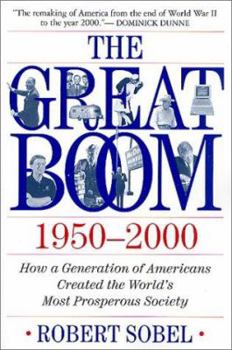The Great Boom, 1950-2000: How a Generation of Americans Created the World's Most Prosperous Society
Select Format
Select Condition 
Book Overview
In "The Great Boom," historian Robert Sobel tells the fascinating story of the last 50 years when American entrepreneurs, visionaries, and ordinary citizens transformed our depression and war-exhausted society into today's economic powerhouse. As America's G.I.s returned home from World War II, many of the nation's best minds predicted a new depression--yet exactly the opposite occurred. Jobs were plentiful in retooled factories swamped with orders from pent-up demand. Tens of thousands of families moved out of cities into affordable suburban homes built by William Levitt and his imitators. They bought cars, televisions, and air conditioners by the millions. And they took to the nation's roads and new interstate highways--the largest public works project in world history--where Kemmons Wilson of Holiday Inns, Ray Kroc of McDonalds, and other start-up entrepreneurs soon catered to a mobile populace with food and lodgings for leisure time vacationers. Americans and their families began to channel savings into new opportunities. Credit cards democratized purchasing power, while early mutual funds found growing numbers of investors to fuel the first postwar bull market in the go-go '60s. At the same time the continuing boom enriched the fabric of social and cultural life. A college education became a must on the highway to upward mobility; high-tech industries arose with astonishing new ways of conducting business electronically; and an unprecedented 49 million families had become investors when the 1981-2000 stock market boom reached 10,000 on the Dow. "The Great Boom" is the first major book to portray the great wave of homegrown entrepreneurs as post-war heroes in the complete remaking and revitalizing of America. All that, plus the creation of unprecedented wealth--or themselves, for the nation, for tens of millions of citizens--all in five short drama-filled decades.
Format:Paperback
Language:English
ISBN:0312288999
ISBN13:9780312288990
Release Date:March 2002
Publisher:St. Martin's Griffin
Length:464 Pages
Weight:1.25 lbs.
Dimensions:1.3" x 6.3" x 9.2"
Customer Reviews
2 ratings
A Good Read!
Published by Thriftbooks.com User , 24 years ago
How did the modern United States get so rich? Robert Sobel presents an overview of American history from the end of World War II to the present, focusing on the economic, social, and technological developments that built wealth in America. The book is an engaging read, especially for anyone who grew up in the early '40s or '50s. Sobel, a professor of business history, wrestles a mass of historical data to the ground, though he sometimes daunts the reader with long, complex sentences or over-ambitious clumps of information. The book unfolds thematically, sometimes skipping about chronologically, so you might wish for charts or graphics that clarify time frames and supplementary material. You'll get over that, as you become absorbed in this otherwise excellent, thoughtful book, which getAbstract.com recommends for its skillful weaving of familiar historical facts and insightful analysis.
Educated Investors Prosper for 50 Years
Published by Thriftbooks.com User , 24 years ago
After World War II, the average economic pundit expected that after a brief period of restocking depleted shelves with consumer products the U.S. economy would lapse in recession or even depression again. Yet just the opposite happened. In this broadscale overview of the American economy from 1950-2000, you will see the milestones of how that pessimistic view was reversed. The book ends on a note of mixed optimism for the 21st century, that should refocus our attention on improving education.For anyone who lived through these years as an adult, I suspect that there will be nothing new. For those who are younger, these milestones and perspectives will make for fascinating reading. For example, my own teenage daughter probably has little understanding of how the economy has developed in the last 50 years. When she is old enough to be curious, this book will make a good nontechnical resource for her.In 1950, suburban housing tracts were just being started, few people owned stocks, a small percentage had been to college, unemployment was starting to rise again, it was hard to travel from one city to another by car, few had televisions, and many people looked to a factory job in Detroit as the ultimate security.Professor Sobel credits a number of continuing themes as being very important for the ensuing economic transformation: The GI Bill and a desire to get ahead sent determined veterans to college in large numbers (who later sent their kids to college also); entrepreneurs developed technology and business processes to create massive new industries based on electronics and mobile Americans (McDonald's and Holiday Inns); the Cold War stimulated demand for directed government support of technology and infrastructure (leading to the Interstate Highway system and the Internet); and innovation transformed almost every area of American life to make rare goods and services attractive, inexpensive, and available to the masses (credit cards, no-load mutual funds,and access to buying art). Basically, these are all the hallmarks of a free society. Where did the new wealth come from? Primarily from home ownership and stock investing. Both were much rarer in 1950, and the prices paid have grown much faster than inflation in both areas. If you bought and held, or bought and traded up, you probably did quite well. If you also started a successful business, you probably did even better. Those who did not do these three things find themselves not very well off from a financial security point of view, but with a higher standard of living than would have occurred in 1950. What about the downside? Professor Sobel doesn't have as much to say in this area, but he is also optimistic there. His statistics point out the the lowest income people had greater economic percentage gains in buying power over these 50 years than the wealthiest did. He also asks that we do more to understand why some are born in and remain i






